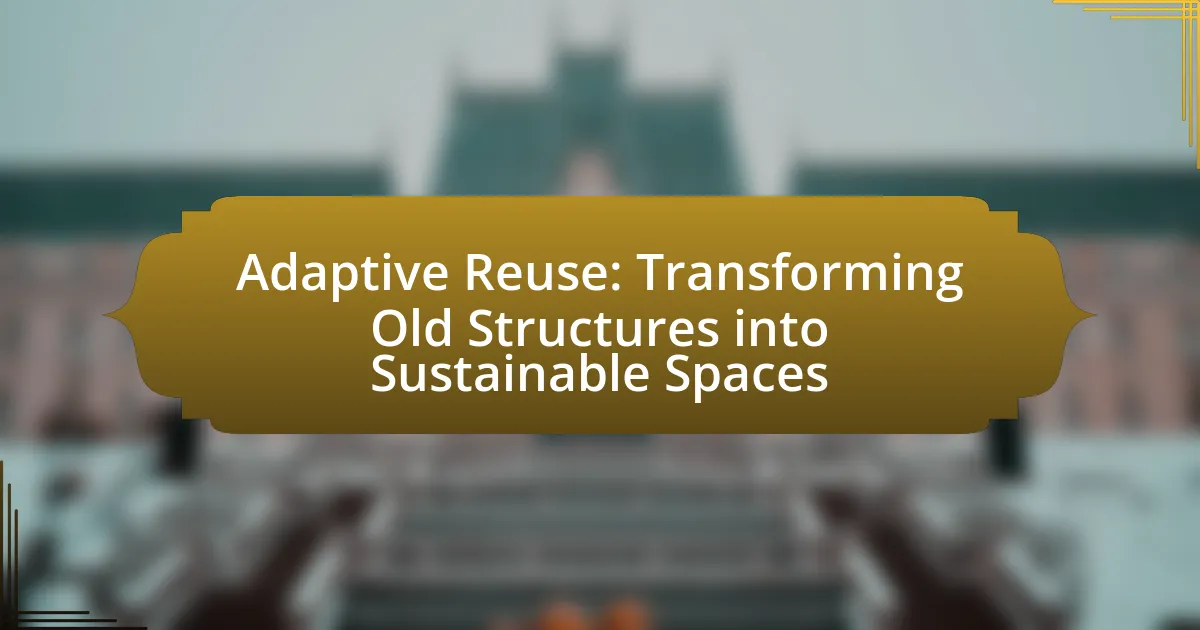Adaptive reuse is the process of repurposing old buildings for new uses while preserving their historic features, contributing to sustainability by minimizing waste and reducing the demand for new construction materials. This practice not only conserves resources but also plays a significant role in community revitalization and cultural heritage preservation. The article explores the environmental benefits of adaptive reuse, the types of structures that can be repurposed, the challenges faced in such projects, and successful case studies that highlight best practices. Additionally, it discusses the importance of community engagement and sustainable design principles in ensuring the success of adaptive reuse initiatives.

What is Adaptive Reuse?
Adaptive reuse is the process of repurposing old buildings for new uses while retaining their historic features. This practice not only preserves cultural heritage but also promotes sustainability by reducing the need for new construction materials and minimizing waste. According to the National Trust for Historic Preservation, adaptive reuse can significantly lower the environmental impact of development, as it often requires fewer resources and energy compared to building new structures from scratch.
How does Adaptive Reuse contribute to sustainability?
Adaptive reuse contributes to sustainability by minimizing waste and reducing the demand for new materials. By repurposing existing structures, adaptive reuse conserves resources and energy that would otherwise be expended in new construction. For instance, a study by the National Trust for Historic Preservation found that reusing a building can save up to 80% of the embodied energy compared to demolishing it and constructing anew. This practice not only preserves cultural heritage but also decreases the carbon footprint associated with construction activities.
What are the environmental benefits of Adaptive Reuse?
Adaptive reuse significantly reduces environmental impact by minimizing waste and conserving resources. By repurposing existing buildings, adaptive reuse decreases the need for new construction materials, which are often resource-intensive to produce. For instance, the National Trust for Historic Preservation states that reusing a building can save up to 80% of the embodied energy compared to new construction. Additionally, adaptive reuse helps preserve cultural heritage and reduces urban sprawl, leading to more sustainable land use. This practice also lowers greenhouse gas emissions associated with demolition and new construction processes, contributing to overall environmental sustainability.
How does Adaptive Reuse reduce waste and resource consumption?
Adaptive reuse reduces waste and resource consumption by repurposing existing buildings instead of demolishing them, which minimizes landfill waste and conserves materials. According to the National Trust for Historic Preservation, adaptive reuse can save up to 50% of the energy required to build new structures, as it utilizes the embodied energy already present in the original materials. This practice not only decreases the demand for new resources but also lessens the environmental impact associated with construction activities, such as carbon emissions and resource extraction.
What types of structures can undergo Adaptive Reuse?
Various types of structures can undergo adaptive reuse, including industrial buildings, warehouses, schools, churches, and historic homes. These structures are often repurposed for new functions, such as residential units, offices, retail spaces, or community centers. The adaptability of these buildings is supported by their existing frameworks, which can be modified to meet contemporary needs while preserving historical significance. For instance, the conversion of factories into loft apartments has become a common practice in urban areas, demonstrating the viability of adaptive reuse in revitalizing neighborhoods and promoting sustainability.
Which historical buildings are commonly repurposed?
Commonly repurposed historical buildings include factories, churches, schools, and warehouses. Factories, such as the Tate Modern in London, have been transformed into art galleries, showcasing the potential for cultural adaptation. Churches, like the St. John the Divine in New York, have been converted into community spaces or event venues, reflecting changing societal needs. Schools, such as the Old School House in Massachusetts, often find new life as residential units or offices, demonstrating the versatility of educational structures. Warehouses, exemplified by the High Line in New York City, have been revitalized into parks and public spaces, highlighting the trend of urban renewal. These examples illustrate the successful adaptive reuse of historical buildings, contributing to sustainability and preserving cultural heritage.
How do commercial spaces adapt to new uses?
Commercial spaces adapt to new uses through a process known as adaptive reuse, which involves modifying existing structures to serve different functions while preserving their historical or architectural significance. This approach not only reduces waste and conserves resources but also revitalizes neighborhoods by integrating modern needs with existing infrastructure. For instance, warehouses can be transformed into residential lofts or retail spaces, as seen in cities like New York and San Francisco, where such conversions have led to increased property values and community engagement. Studies indicate that adaptive reuse projects can reduce construction waste by up to 80%, demonstrating their sustainability and efficiency in meeting contemporary demands.
Why is Adaptive Reuse important in urban development?
Adaptive reuse is important in urban development because it promotes sustainability by repurposing existing structures rather than demolishing them. This practice reduces waste, conserves resources, and minimizes the environmental impact associated with new construction. For instance, a study by the National Trust for Historic Preservation found that adaptive reuse can save up to 50% of the energy required to build new structures, highlighting its efficiency in resource utilization. Additionally, adaptive reuse often revitalizes neighborhoods, enhances cultural heritage, and stimulates local economies by attracting businesses and tourism, thereby contributing to the overall vitality of urban areas.
How does Adaptive Reuse impact community revitalization?
Adaptive reuse significantly impacts community revitalization by transforming underutilized or abandoned buildings into functional spaces that meet current community needs. This process not only preserves historical architecture but also stimulates local economies by attracting new businesses and residents. For instance, a study by the National Trust for Historic Preservation found that adaptive reuse projects can generate up to 50% more jobs compared to new construction, highlighting their economic benefits. Additionally, revitalized spaces often enhance community identity and pride, fostering social cohesion and engagement among residents.
What role does Adaptive Reuse play in preserving cultural heritage?
Adaptive reuse plays a critical role in preserving cultural heritage by allowing historic buildings to be repurposed for modern use while maintaining their architectural integrity and historical significance. This practice not only conserves the physical structure but also fosters a connection to the past, enabling communities to retain their cultural identity. For instance, the transformation of the Tate Modern in London from a power station into a contemporary art museum exemplifies how adaptive reuse can revitalize a space, attract tourism, and promote cultural engagement, all while honoring the building’s historical context.

What are the challenges of Adaptive Reuse?
The challenges of adaptive reuse include structural limitations, regulatory hurdles, and financial constraints. Structural limitations arise when existing buildings do not meet modern safety or functional standards, necessitating significant modifications. Regulatory hurdles often involve navigating complex zoning laws and building codes that can restrict the intended use of the space. Financial constraints are prevalent as the costs associated with renovation can exceed initial budgets, particularly if unforeseen issues arise during the renovation process. According to a study by the National Trust for Historic Preservation, approximately 30% of adaptive reuse projects face budget overruns due to these challenges, highlighting the need for careful planning and assessment.
What regulatory hurdles must be navigated in Adaptive Reuse projects?
Adaptive reuse projects must navigate several regulatory hurdles, including zoning laws, building codes, and historic preservation regulations. Zoning laws can restrict the types of activities allowed in a repurposed building, requiring developers to seek variances or special permits. Building codes may necessitate significant modifications to meet current safety and accessibility standards, which can complicate the renovation process. Additionally, if the structure is historically significant, compliance with preservation regulations is mandatory, often limiting alterations and requiring approval from local historic commissions. These regulatory challenges can delay projects and increase costs, making thorough planning and consultation with regulatory bodies essential for successful adaptive reuse.
How do zoning laws affect Adaptive Reuse initiatives?
Zoning laws significantly influence Adaptive Reuse initiatives by dictating the permissible uses of buildings and land. These regulations can either facilitate or hinder the transformation of existing structures into new functional spaces, as they establish the types of activities allowed in specific areas. For instance, if zoning laws restrict a building’s use to residential purposes, converting it into a commercial space may not be permitted, thereby limiting the potential for adaptive reuse. Additionally, zoning codes may impose requirements related to building height, density, and parking, which can affect the feasibility of redevelopment projects. In cities like San Francisco, adaptive reuse projects have thrived due to flexible zoning regulations that encourage the repurposing of historic buildings, demonstrating how supportive zoning can enhance sustainability and urban revitalization.
What are the common financial challenges faced in these projects?
Common financial challenges faced in adaptive reuse projects include high initial costs, unexpected structural issues, and fluctuating market conditions. High initial costs arise from the need for extensive renovations and compliance with modern building codes, which can significantly exceed initial budgets. Unexpected structural issues, such as hidden damage or the need for additional reinforcements, can lead to increased expenses during the renovation process. Fluctuating market conditions can impact financing options and the overall return on investment, making it difficult to secure funding or achieve projected profitability. These challenges are well-documented in industry reports, such as the National Trust for Historic Preservation’s findings on the economic impacts of adaptive reuse.
How can design influence the success of Adaptive Reuse?
Design significantly influences the success of adaptive reuse by enhancing functionality, aesthetic appeal, and sustainability of existing structures. Effective design strategies, such as integrating modern amenities while preserving historical elements, can attract new users and ensure the building meets contemporary needs. For instance, a study by the National Trust for Historic Preservation found that well-designed adaptive reuse projects can increase property values by up to 20% and stimulate local economies. Additionally, incorporating energy-efficient systems and sustainable materials in the design process can reduce operational costs and environmental impact, further contributing to the project’s overall success.
What design strategies enhance functionality in repurposed spaces?
Design strategies that enhance functionality in repurposed spaces include flexible layouts, multifunctional furniture, and the integration of natural light. Flexible layouts allow for adaptable use of space, accommodating various activities and needs over time. Multifunctional furniture maximizes utility by serving multiple purposes, such as a sofa that converts into a bed or tables that can be expanded or collapsed. The integration of natural light improves the ambiance and reduces reliance on artificial lighting, contributing to energy efficiency. These strategies are supported by studies indicating that well-designed repurposed spaces can lead to increased user satisfaction and improved functionality, as seen in successful adaptive reuse projects worldwide.
How does community input shape the design of Adaptive Reuse projects?
Community input significantly shapes the design of Adaptive Reuse projects by ensuring that the transformed spaces meet the needs and preferences of local residents. Engaging the community allows architects and developers to gather insights on desired functionalities, aesthetic considerations, and cultural significance, which can lead to designs that foster a sense of ownership and pride among users. For instance, studies have shown that projects incorporating community feedback tend to achieve higher levels of public support and usage, as seen in the successful transformation of the High Line in New York City, where local input was integral to its design and programming. This collaborative approach not only enhances the relevance of the project but also promotes sustainability by aligning the reuse of structures with the community’s vision and values.

What are successful examples of Adaptive Reuse?
Successful examples of adaptive reuse include the High Line in New York City, which transformed an abandoned elevated railway into a public park, and the Tate Modern in London, which repurposed a former power station into a contemporary art museum. The High Line has become a model for urban revitalization, attracting millions of visitors annually and enhancing local property values. The Tate Modern, since its opening in 2000, has significantly increased cultural tourism in London, drawing over 5 million visitors each year and showcasing the potential of reimagining industrial spaces for public use.
What notable projects exemplify successful Adaptive Reuse?
Notable projects that exemplify successful Adaptive Reuse include the High Line in New York City, which transformed an abandoned elevated railway into a public park, and the Tate Modern in London, which converted a former power station into a contemporary art museum. The High Line, completed in 2009, has become a model for urban revitalization, attracting millions of visitors and enhancing local property values. The Tate Modern, opened in 2000, has significantly increased cultural engagement and tourism in the area, showcasing how repurposing industrial buildings can create vibrant community spaces.
How did the transformation of industrial buildings into residential spaces succeed?
The transformation of industrial buildings into residential spaces succeeded primarily due to the growing demand for urban housing and the unique architectural features of these structures. Urbanization and population growth in cities increased the need for housing, prompting developers to repurpose underutilized industrial sites. The distinctive characteristics of industrial buildings, such as high ceilings, large windows, and open floor plans, appealed to buyers seeking modern living spaces with character.
Additionally, financial incentives, such as tax credits and grants for adaptive reuse projects, further facilitated this transformation. According to the National Trust for Historic Preservation, adaptive reuse projects can significantly reduce construction waste and lower environmental impact, aligning with sustainability goals. This combination of market demand, architectural appeal, and supportive policies contributed to the successful conversion of industrial buildings into desirable residential properties.
What lessons can be learned from successful Adaptive Reuse case studies?
Successful Adaptive Reuse case studies demonstrate the importance of preserving historical integrity while integrating modern functionality. These projects often highlight the value of community engagement in the planning process, ensuring that the new use aligns with local needs and cultural significance. For instance, the transformation of the High Line in New York City from an abandoned railway to a public park involved extensive community input, resulting in a space that enhances urban life and boosts local economies. Additionally, successful case studies emphasize the necessity of sustainable design practices, such as energy efficiency and the use of recycled materials, which contribute to environmental conservation. The Tate Modern in London exemplifies this by converting a former power station into a cultural hub, showcasing how adaptive reuse can revitalize urban areas while minimizing waste.
What best practices should be followed in Adaptive Reuse?
Best practices in adaptive reuse include thorough site analysis, community engagement, and sustainable design principles. Conducting a comprehensive site analysis ensures that the existing structure’s strengths and weaknesses are identified, allowing for informed decision-making. Engaging the community fosters support and gathers valuable input, which can enhance the project’s relevance and acceptance. Implementing sustainable design principles, such as energy efficiency and the use of recycled materials, not only reduces environmental impact but also aligns with contemporary architectural standards. These practices are supported by case studies showing that projects incorporating these elements tend to achieve higher success rates and community satisfaction.
How can project managers ensure stakeholder engagement?
Project managers can ensure stakeholder engagement by actively involving stakeholders throughout the project lifecycle. This involves regular communication, soliciting feedback, and addressing concerns promptly. For instance, studies show that projects with consistent stakeholder involvement have a 20% higher success rate, as stakeholders feel valued and invested in the project’s outcomes. By utilizing tools such as stakeholder analysis and engagement plans, project managers can identify key stakeholders, understand their interests, and tailor communication strategies accordingly, thereby fostering a collaborative environment essential for successful adaptive reuse projects.
What are the key considerations for sustainable materials in Adaptive Reuse?
Key considerations for sustainable materials in adaptive reuse include material durability, environmental impact, and historical significance. Durable materials ensure longevity and reduce the need for future replacements, thereby minimizing waste. The environmental impact of materials, such as their carbon footprint and recyclability, is crucial; for instance, using reclaimed wood or recycled metals can significantly lower resource consumption. Additionally, materials that respect and reflect the historical context of the original structure contribute to cultural preservation while promoting sustainability. These considerations align with the principles of sustainable architecture, which advocate for reducing environmental harm and enhancing the lifecycle of existing buildings.
How can individuals get involved in Adaptive Reuse initiatives?
Individuals can get involved in Adaptive Reuse initiatives by participating in local community planning meetings, volunteering for organizations focused on preservation and sustainability, and advocating for policies that support adaptive reuse projects. Engaging in these activities allows individuals to contribute to the transformation of old structures into sustainable spaces, which has been shown to reduce waste and promote environmental stewardship. For example, the National Trust for Historic Preservation highlights that adaptive reuse can save up to 50% of the energy required to build new structures, demonstrating the significant impact of community involvement in these initiatives.

Leave a Reply